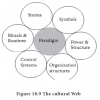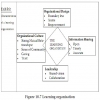Strategic Management - Strategy Implementation
Approaches to Managing Change
Posted On :
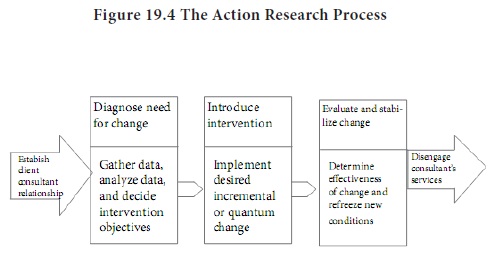
The three most popular approaches to manage change are i. Lewin’s three step model ii. Action research and iii. Organizational development
Approaches to Managing Change
The three most popular approaches to manage change are
i. Lewin’s three step model
ii. Action research and
iii. Organizational development
Kurt Lewin argued that successful change in organizations should follow three steps as shown in Figure 19-2. Unfreezing is the release of forces dormant in the status quo. Movement is transforming form old to new situation or to a new state. Refreezing is consolidation in the new situation to make change permanent.

Every change situation Kurt Lewin presents as a force field as depicted in Figure 19-3. The status quo can be considered to be an equilibrium state. To move from this equilibrium-to overcome the pressures of both individual resistance and group conformity –unfreezing is necessary. It can be achieved in one of three ways.
The driving forces, which lead to change, can be strengthened. The restraining forces, which hinder movement from the existing equilibrium, can be decreased. A third alternative is to combine the first two approaches.
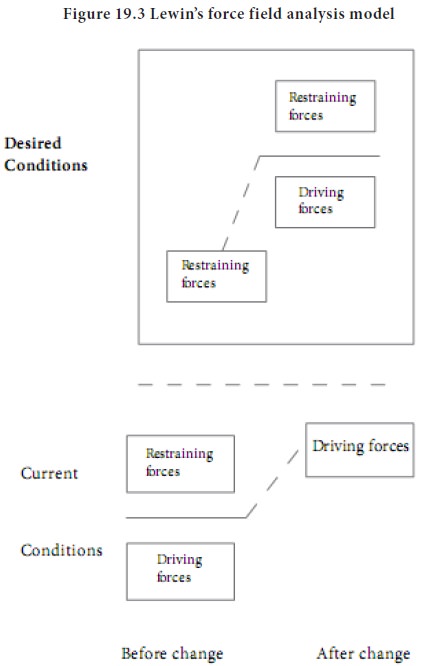
Action research is a data-based, problem-oriented process that diagnose the need for change, introduce the intervention and then evaluates and stabilizer the deserved changes. The Action research process is given in Figure 19-4
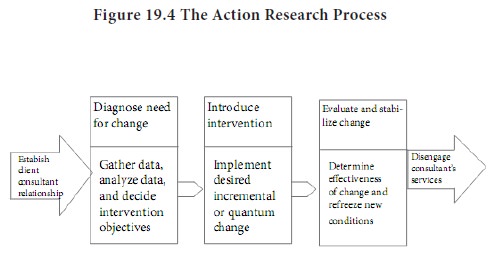
1. Establish client-consultant relationship – Action research usually assumes that the change agent originates outside the system (such as a consultant), so the process begins by forming the client-consultant relationship. Process consultation is a method of helping people within the system solve their own problems by making them aware of organizational processes, the consequences of those processes, and the means by which they can be changed.
2. Diagnose the need for change – Action research is a problem-oriented activity that carefully diagnoses the problem through systematic analysis of the situation
3. Introduce intervention – This stage in the action research model applies one or more actions to correct the problem. It may include any of the prescriptions mentioned in this textbook, such as building more effective teams, managing conflict, building a better organizational structure, or changing the corporate culture. Some experts recommend incremental change in which the organization fine-tunes the system and takes small steps toward a desired state. Others claim that quantum change is often required in which the system is overhauled decisively and quickly.
4. Evaluate and stabilize change – Action research recommends evaluating the effectiveness of the intervention against the standards established in the diagnostic stage.
The action research approach has dominated organizational change thinking eve since it was introduced in the 1940s.
Organizational development (OD encompasses a collection of planned-change interventions built on humanistic-democratic values that seek to improve organizational effectiveness and employee well-being. The following briefly identifies the underlying values in most OD efforts.
1. Respect for people Individuals are perceived as being responsible, conscientious, and caring. They should be treated with dignity and respect.
2. Trust and support The effective and healthy organization is characterized by trust, authenticity, openness, and a supportive climate.
3. Power equalization Effective, organizations deemphasize hierarchical authority and control
4. Conformation Problems shouldn’t be swept under the rug. They should be openly confronted.
5. Participation The more that people who will be affected by a change are involved in the decisions surrounding that change, the more they will be committed to implementing those decisions.
There are broadly six OD interventions discussed by experts of organizational behavior
1. Sensitivity training – This is done in training groups that seek to change behavior through unstructured group interaction. It can go by a variety of names – sensitivity training, laboratory training, encounter groups, or T-groups (training groups. Members are brought together in a free and open environment in which participants discuss themselves and their interactive processes, loosely directed by a professional behavioral scientist. The group is process-oriented, which means that individuals learn through observing and participating rather than being told.
2. Survey feed back – Uses questionnaire to identify discrepancies
3. Process consultation – A consultant assist a client to understand process events with which he or she must deal and identify processes that need improvement. These might include work flow, informal relationships among unit members, and formal communication channels. Process Consultation is more tasks-directed than is sensitivity training.
4. Team building – uses high-interaction group activities to increase trust and openness among team members. Team building can be applied within groups or at the inter group level, at which activities are interdependent.
5. Inter group development – These include efforts to change the attitudes, stereotypes and perceptions that groups have of each other. This approach used problem solving techniques.
6. Appreciative enquiry - Seeks to identify the unique qualities and special strengths of an organization, which can then be built on to improve performance.
The three most popular approaches to manage change are
i. Lewin’s three step model
ii. Action research and
iii. Organizational development
I) Lewin’s Three Step Model
Kurt Lewin argued that successful change in organizations should follow three steps as shown in Figure 19-2. Unfreezing is the release of forces dormant in the status quo. Movement is transforming form old to new situation or to a new state. Refreezing is consolidation in the new situation to make change permanent.

Every change situation Kurt Lewin presents as a force field as depicted in Figure 19-3. The status quo can be considered to be an equilibrium state. To move from this equilibrium-to overcome the pressures of both individual resistance and group conformity –unfreezing is necessary. It can be achieved in one of three ways.
The driving forces, which lead to change, can be strengthened. The restraining forces, which hinder movement from the existing equilibrium, can be decreased. A third alternative is to combine the first two approaches.

II) Action Research
Action research is a data-based, problem-oriented process that diagnose the need for change, introduce the intervention and then evaluates and stabilizer the deserved changes. The Action research process is given in Figure 19-4

1. Establish client-consultant relationship – Action research usually assumes that the change agent originates outside the system (such as a consultant), so the process begins by forming the client-consultant relationship. Process consultation is a method of helping people within the system solve their own problems by making them aware of organizational processes, the consequences of those processes, and the means by which they can be changed.
2. Diagnose the need for change – Action research is a problem-oriented activity that carefully diagnoses the problem through systematic analysis of the situation
3. Introduce intervention – This stage in the action research model applies one or more actions to correct the problem. It may include any of the prescriptions mentioned in this textbook, such as building more effective teams, managing conflict, building a better organizational structure, or changing the corporate culture. Some experts recommend incremental change in which the organization fine-tunes the system and takes small steps toward a desired state. Others claim that quantum change is often required in which the system is overhauled decisively and quickly.
4. Evaluate and stabilize change – Action research recommends evaluating the effectiveness of the intervention against the standards established in the diagnostic stage.
The action research approach has dominated organizational change thinking eve since it was introduced in the 1940s.
III) Organizational Development (OD)
Organizational development (OD encompasses a collection of planned-change interventions built on humanistic-democratic values that seek to improve organizational effectiveness and employee well-being. The following briefly identifies the underlying values in most OD efforts.
1. Respect for people Individuals are perceived as being responsible, conscientious, and caring. They should be treated with dignity and respect.
2. Trust and support The effective and healthy organization is characterized by trust, authenticity, openness, and a supportive climate.
3. Power equalization Effective, organizations deemphasize hierarchical authority and control
4. Conformation Problems shouldn’t be swept under the rug. They should be openly confronted.
5. Participation The more that people who will be affected by a change are involved in the decisions surrounding that change, the more they will be committed to implementing those decisions.
There are broadly six OD interventions discussed by experts of organizational behavior
1. Sensitivity training – This is done in training groups that seek to change behavior through unstructured group interaction. It can go by a variety of names – sensitivity training, laboratory training, encounter groups, or T-groups (training groups. Members are brought together in a free and open environment in which participants discuss themselves and their interactive processes, loosely directed by a professional behavioral scientist. The group is process-oriented, which means that individuals learn through observing and participating rather than being told.
2. Survey feed back – Uses questionnaire to identify discrepancies
3. Process consultation – A consultant assist a client to understand process events with which he or she must deal and identify processes that need improvement. These might include work flow, informal relationships among unit members, and formal communication channels. Process Consultation is more tasks-directed than is sensitivity training.
4. Team building – uses high-interaction group activities to increase trust and openness among team members. Team building can be applied within groups or at the inter group level, at which activities are interdependent.
5. Inter group development – These include efforts to change the attitudes, stereotypes and perceptions that groups have of each other. This approach used problem solving techniques.
6. Appreciative enquiry - Seeks to identify the unique qualities and special strengths of an organization, which can then be built on to improve performance.
Tags : Strategic Management - Strategy Implementation
Last 30 days 602 views














